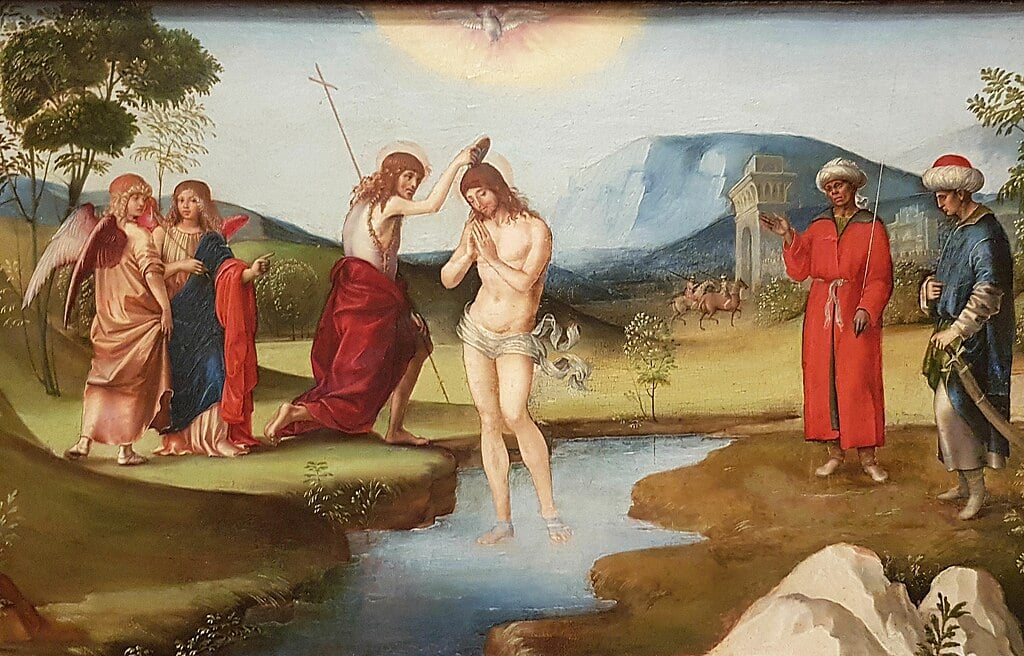Jesus' Baptism & Preparation (AQA GCSE Religious Studies A): Revision Note
Exam code: 8062
9 In those days Jesus came from Nazareth of Galilee and was baptized by John in the Jordan. 10 And just as he was coming up out of the water, he saw the heavens torn apart and the Spirit descending like a dove on him. 11 And a voice came from heaven, “You are my Son, the Beloved; with you I am well pleased.” 12 And the Spirit immediately drove him out into the wilderness. 13 He was in the wilderness for forty days, tempted by Satan; and he was with the wild beasts; and the angels waited on him. (Mark 1:9–13)
Symbolism in Jesus’s baptism

The Baptism of Jesus
Attribution:
Portugal, Lisbon, Gulbenkian Museum, The Baptism of Christ, Piero della Francesca, Public Domain
The baptism of Jesus in this passage marks the start of his public ministry
It is believed to have happened between 27 and 30 CE
There is no birth account or any stories from Jesus’s childhood in St Mark’s Gospel: This is the first event Mark records of Jesus’s life
There are several symbols in this passage that show how significant the event was
Water
John had already been baptising people with water in the River Jordan as a sign of repentance
Jesus would have been aware that this symbol of baptism meant cleansing and new life
Water has significance in several other ways in the Old Testament:
Life and blessings from God: Flowing (“living”) water was seen as a gift from God, essential for crops, animals and people. God is called the “spring of living water” (Jeremiah 2:13), showing his life-giving presence
Salvation and new beginnings: Major events involving water such as the crossing of the Red Sea (Exodus 14) symbolised God rescuing his people and leading them to a better life
Heavens torn apart
This was a sign of God’s presence
The prophet Isaiah in the Old Testament spoke of the heavens being torn apart, saying “O that you would tear open the heavens and come down” (Isaiah 64:1)
This shows that Jesus was fulfilling this prophecy and that this was a very important event
The dove
The passage says that the Holy Spirit descended “like a dove”
Doves are a sign of God’s presence
In the Old Testament, Noah released a dove at the end of the great flood. When it returned with an olive branch, Noah knew the flood was over
Doves also symbolise peace
In the above passage, the Holy Spirit comes down to give Jesus strength for his public ministry, which was about to begin
The voice
Although the voice in this passage is not explicitly said to be God’s, it does come “from heaven”
This fits with a Jewish teaching about the bat qol, or voice from heaven: It symbolises God’s presence
The voice tells Jesus that Jesus is his son and that he is “well pleased” with Jesus, showing Jesus’s importance to God
This is the moment when Jesus was given his mission
The temptations
Immediately after his baptism, Jesus went out into the wilderness for forty days, where he was “tempted by Satan”
This symbolises Jesus being tempted away from God straightaway, before he even began his mission
The “wild beasts” are often interpreted as demons, going against God
Jesus did not give into temptation; instead, there were “angels” to care for him, symbolising that God kept him safe at this time
Baptism and temptation for Christians today
The tale of Jesus’s baptism and temptations is significant for Christians today
For most Christians, baptism is their initiation into God’s family, the Christian faith
They are baptised with water, just as Jesus was, and some practice believers’ (adult) baptism, just as Jesus did
Jesus’s baptism shows Christians that Jesus identified with humans as someone who needed to be cleansed, even though he had no sin
The baptism of Jesus showed that he fulfilled the Old Testament prophecies and was the Messiah
It is also an important symbol of the Holy Trinity: It is the occasion when all three persons of the Trinity are present in the same scene
God the Father is the voice from heaven
God the Son is Jesus
God the Holy Spirit appears as a dove
The temptation of Jesus in the wilderness shows Christians that they are not alone in experiencing temptations in their lives
Jesus sets the example that they should follow: resisting temptation and staying strong in their faith
Many Christians remember this during the period of Lent before Easter each year; they give something up or do extra good deeds during this time to help them with their self-discipline
Worked Example
Which one of the following symbols at Jesus’s baptism is linked to the presence of the Holy Spirit?
[1 mark]
A. The tearing open of the heavens
B. The dove descending
C. The voice from heaven
D. The wild beasts in the wilderness
Answer:
B. The dove descending
In Mark 1:10, the Holy Spirit is said to descend on Jesus “like a dove”. So the dove is the symbol linked directly to the Holy Spirit.
Examiner Tips and Tricks
The temptations of Jesus are related in much greater detail in Matthew and Luke’s gospels. Mark is always in a rush and tells stories more concisely. So don’t get confused and add in extra details if you’re familiar with the accounts in the other gospels.

Unlock more, it's free!
Did this page help you?